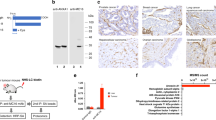Abstract
Purpose
5,6-Dimethylxanthenone-4-acetic acid (DMXAA) (AS1404), a small-molecule vascular disrupting agent currently in clinical trial, increases vascular permeability and decreases blood flow in both murine and human tumours. DMXAA induces tumour necrosis factor (TNF) in mice and the effects on vascular permeability are hypothesised to result from both direct (DMXAA) and indirect (TNF) effects. Skin temperature decreases in mice treated with high doses of DMXAA, raising the question of whether host toxicity is mediated by the induction of increased vascular permeability in normal tissue. Thalidomide is an anti-inflammatory agent that potentiates the anti-tumour activity of DMXAA but decreases induction of TNF in plasma. We wished to determine how it potentiated the effects of DMXAA.
Methods
Vascular permeability was measured in Colon 38 tumour and liver tissue by uptake of Evans Blue dye. Blood haematocrit and body temperature were also measured.
Results
Tumour vascular permeability was increased following administration of DMXAA (25 mg/kg i.p.), minimally affected following thalidomide (100 mg/kg i.p.) but strongly increased following co-administration of both drugs. In contrast, dye uptake into liver tissue was decreased following administration of DMXAA, thalidomide or both drugs. Administration of DMXAA at a potentially toxic dose (35 mg/kg i.p. or 50 mg/kg orally) was found to decrease body temperature and to increase the blood haematocrit, while administration of thalidomide alone (100 mg/kg i.p.) had no effect. Co-administration of thalidomide potentiated the effects of DMXAA on both body temperature and haematocrit but surprisingly did not increase toxicity.
Conclusions
The results are consistent with the hypothesis that the host toxicity of high-dose DMXAA is mediated by effects on host vasculature. Co-administration of thalidomide increases the effective dose of DMXAA by reducing clearance but also, by inhibiting production of circulating TNF, reduces the host toxicity of DMXAA.




Similar content being viewed by others
References
Baguley BC (2003) Antivascular therapy of cancer: DMXAA. Lancet Oncol 4:141–148
Caster W, Simon A, Armstrong W (2006) A direct method for the determination of Evans blue using zephiran as a solvent. J Lab Clin Med 42:493–498
Ching LM, Goldsmith D, Joseph WR, Korner H, Sedgwick JD, Baguley BC (1999) Induction of intratumoral tumor necrosis factor (TNF) synthesis and hemorrhagic necrosis by 5,6-dimethylxanthenone-4-acetic acid (DMXAA) in TNF knockout mice. Cancer Res 59:3304–3307
Ching LM, Xu ZF, Gummer BH, Palmer BD, Joseph WR, Baguley BC (1995) Effect of thalidomide on tumour necrosis factor production and anti- tumour activity induced by 5,6-dimethylxanthenone-4-acetic acid. Br J Cancer 72:339–343
Ching LM, Zwain S, Baguley BC (2004) Relationship between tumour endothelial cell apoptosis and tumour blood flow shutdown following treatment with the antivascular agent DMXAA in mice. Br J Cancer 90:906–910
Chung F, Wang LC, Kestell P, Baguley BC, Ching LM (2004) Modulation of thalidomide pharmacokinetics by cyclophosphamide or 5,6-dimethylxanthenone-4-acetic acid (DMXAA) in mice: the role of tumour necrosis factor. Cancer Chemother Pharmacol 53:377–383
Fraser R, Dobbs BR, Rogers GWT (1995) Lipoproteins and the liver sieve: the role of the fenestrated sinusoidal endothelium in lipoprotein metabolism, atherosclerosis, and cirrhosis. Hepatology 19:863–874
Jameson MB, Baguley BC, Kestell P, Zhao L, Paxton JW, Thompson PI (2007) Pharmacokinetics of 5,6-dimethylxanthenone-4-acetic acid (DMXAA), a novel vascular disrupting agent, in a phase I clinical trial. Cancer Chemother Pharmacol 59:681–687
Jameson MB, Thompson PI, Baguley BC, Evans BD, Harvey VJ, Porter DJ, McCrystal MR, Small M, Bellenger K, Gumbrell L, Halbert GW, Kestell P (2003) Clinical aspects of a phase I trial of 5,6-dimethylxanthenone-4-acetic acid (DMXAA), a novel antivascular agent. Br J Cancer 88:1844–1850
Kestell P, Zhao L, Baguley BC, Palmer BD, Muller G, Paxton JW, Ching LM (2000) Modulation of the pharmacokinetics of the antitumour agent 5,6- dimethylxanthenone-4-acetic acid (DMXAA) in mice by thalidomide. Cancer Chemother Pharmacol 46:135–141
Liu J, Ching LM, Goldthorpe N, Sutherland R, Baguley BC, Kirker J, McKeage MJ (2007) Antitumour action of 5,6-dimethylxanthenone-4-acetic acid (DMXAA) in rats bearing chemically-induced primary mammary tumours. J Clin Oncol 59:661–669
Matsumura Y, Maeda H (1986) A new concept for macromolecular therapeutics in cancer chemothrapy: mechanism of tumoritropic accumulation of proteins and the antitumor agent smancs. Cancer Res 46:6387–6392
McKeage MJ, AS1404-201 Study Group Investigators (2006) Phase Ib/II study of DMXAA combined with carboplatin and paclitaxel in non-small cell lung cancer (NSCLC). J Clin Oncol 24:18S (No. 7102)
McKeage MJ, Fong P, Jeffery M, Baguley BC, Kestell P, Ravic M, Jameson MB (2006) 5,6-Dimethylxanthenone-4-acetic acid in the treatment of refractory tumors: a phase I safety study of a vascular disrupting agent. Clin Cancer Res 12:1776–1784
Royall JA, Berkow RL, Beckman JS, Cunningham MK, Matalon S, Freeman BA (1989) Tumor necrosis factor and interleukin 1-alpha increase vascular endothelial permeability. Am J Physiol 257:L399–L410
Tozer GM, Kanthou C, Baguley BC (2005) Disrupting tumour blood vessels. Nat Rev Cancer 5:423–435
Zhao L, Ching LM, Kestell P, Baguley BC (2002) The antitumour activity of 5,6-dimethylxanthenone-4-acetic acid (DMXAA) in TNF receptor-1 knockout mice. Br J Cancer 87:465–470
Zhao L, Ching LM, Kestell P, Kelland LR, Baguley BC (2005) Mechanisms of tumor vascular shut-down induced by 5,6-dimethylxanthenone-4-acetic acid (DMXAA); increased tumor vascular permeability. Int J Cancer 116:322
Zhao L, Marshall E, Kelland LR, Baguley BC (2007) Evidence for the involvement of p38 MAP kinase in the action of the vascular disrupting agent 5,6-dimethylxanthenone-4-acetic acid (DMXAA). Invest New Drugs (in press). http://www.springerlink.com/content/g05v285g0082512
Zwi LJ, Baguley BC, Gavin JB, Wilson WR (1994) Correlation between immune and vascular activities of xanthenone acetic acid antitumor agents. Oncol Res 6:79
Acknowledgements
The authors thank the Auckland Cancer Society for support for this study. This work was supported by the Auckland Cancer Society and by the Health Research Council of New Zealand.
Author information
Authors and Affiliations
Corresponding author
Rights and permissions
About this article
Cite this article
Chung, F., Liu, J., Ching, LM. et al. Consequences of increased vascular permeability induced by treatment of mice with 5,6-dimethylxanthenone-4-acetic acid (DMXAA) and thalidomide. Cancer Chemother Pharmacol 61, 497–502 (2008). https://doi.org/10.1007/s00280-007-0495-7
Received:
Accepted:
Published:
Issue Date:
DOI: https://doi.org/10.1007/s00280-007-0495-7




